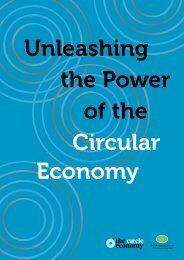ALIGNING PROFIT AND ENVIRONMENTAL SUSTAINABILITY: STORIES FROM INDUSTRY
ALIGNING PROFIT AND ENVIRONMENTAL SUSTAINABILITY: STORIES FROM INDUSTRY
ALIGNING PROFIT AND ENVIRONMENTAL SUSTAINABILITY: STORIES FROM INDUSTRY
You also want an ePaper? Increase the reach of your titles
YUMPU automatically turns print PDFs into web optimized ePapers that Google loves.
Siemens<br />
Siemens is a 165-year-old integrated technology company present in about<br />
190 countries, with business activities in the Energy, Healthcare, Industry,<br />
and Infrastructure and Cities sectors. Siemens has 370,000 employees and<br />
188 major R&D facilities, which generated around €78 billion (US$104<br />
billion) in revenues in 2012. Siemens’ sustainability program has three<br />
categories: Business Opportunities, Walk the Talk, and Stakeholder Engagement.<br />
Growth of its Environmental Portfolio is a priority in the Business<br />
Opportunities category and contributes to the company’s “One Siemens”<br />
framework of creating value.<br />
PROBLEM TO BE SOLVED<br />
Siemens offers products, solutions and services for energy efficiency and<br />
resource productivity to customers increasingly subject to more stringent<br />
regulatory conditions, compliance rules, and a need to cut their energy<br />
costs. The demand for ever better performance in terms of energy efficiency<br />
and greenhouse gas emissions mitigation is increasing. In response,<br />
Siemens wanted to grow its offering of products, solutions and services<br />
that have a positive environmental profile, while also growing its business<br />
and creating opportunities in emerging markets. It therefore developed its<br />
Environmental Portfolio.<br />
Figure 3 | Criteria for the Environmental Portfolio<br />
12 |<br />
ENERGY EFFICIENT<br />
PRODUCTS <strong>AND</strong> SOLUTIONS<br />
Products and solutions with outstanding<br />
energy efficiency qualify<br />
Examples:<br />
Combined cycle power plants<br />
High-voltage direct-current<br />
transmission<br />
Intelligent building automation<br />
RENEWABLE ENERGY<br />
STRATEGY<br />
All renewable technologies qualify<br />
Examples:<br />
Offshore wind farms<br />
Steam turbines for solar energy<br />
Source: Derived from “The Siemens Environmental Portfolio – Examples of Sustainable Technologies,”<br />
2012, p. 4; siemens.com/environmentalportfolio and interviews with company representatives.<br />
Siemens’ intent for its Environmental Portfolio is to provide products and<br />
solutions that offer benefits in three categories:<br />
Customers: improve their own business success due to lower energy and<br />
resource costs, higher productivity, and profitable growth;<br />
Society: protect the environment and improve standards of living through<br />
use of Siemens’ technologies;<br />
Siemens: expand in attractive markets and grow in profitability. 21<br />
Formally launched in 2008, the Siemens Environmental Portfolio largely consists<br />
of capital goods with long life cycles. Examples include wind turbines,<br />
highly efficient combined cycle power plants, components for biomass power<br />
plants, building technologies, efficient trains, and energy saving motors. The<br />
company uses a publically available methodology to account for the greenhouse<br />
gases (GHG) and energy savings of its Environmental Portfolio and<br />
has these results audited by a third party according to a limited assurance<br />
engagement. 22 Environmental regulations, high energy prices, and a price<br />
on carbon (in Europe) have helped to drive demand for the types of products<br />
in Siemens Environmental Portfolio. As a result, the company has focused<br />
innovation and development activities on green technologies. Products and<br />
solutions in the Environmental Portfolio must meet specific criteria. For<br />
example, the energy efficiency criterion requires products in this category to<br />
offer energy savings of at least 20 percent or at least 100,000 metric tons of<br />
CO 2 -eq by the number of units sold in the use phase compared to a baseline.<br />
<strong>ENVIRONMENTAL</strong> TECHNOLOGIES<br />
All environmental technologies qualify<br />
Examples:<br />
Technologies for water treatment<br />
Air pollution control systems<br />
E-car charging stations



